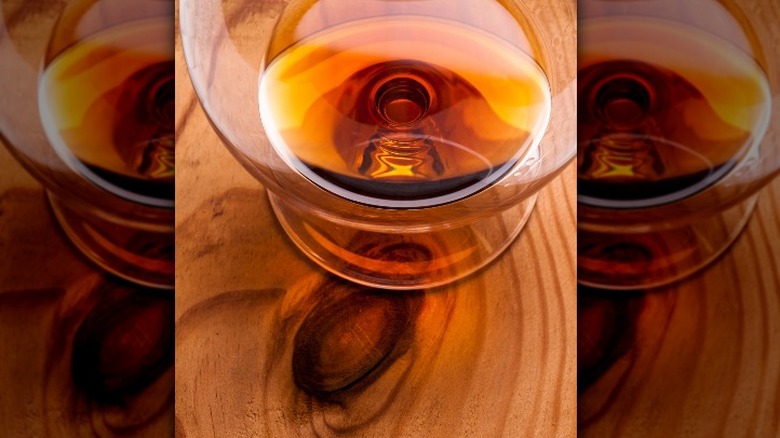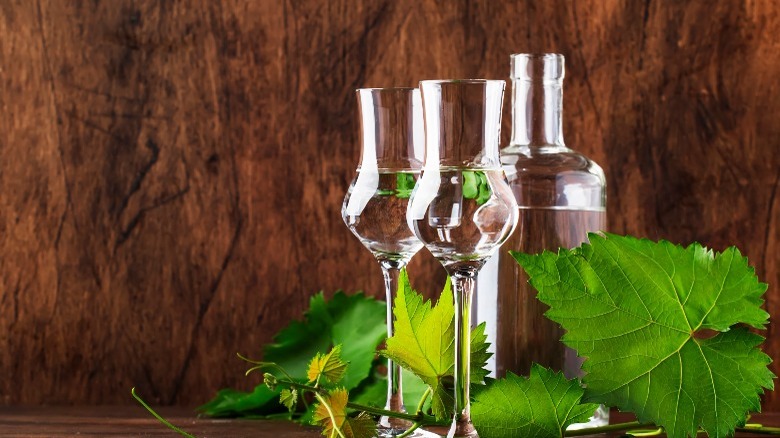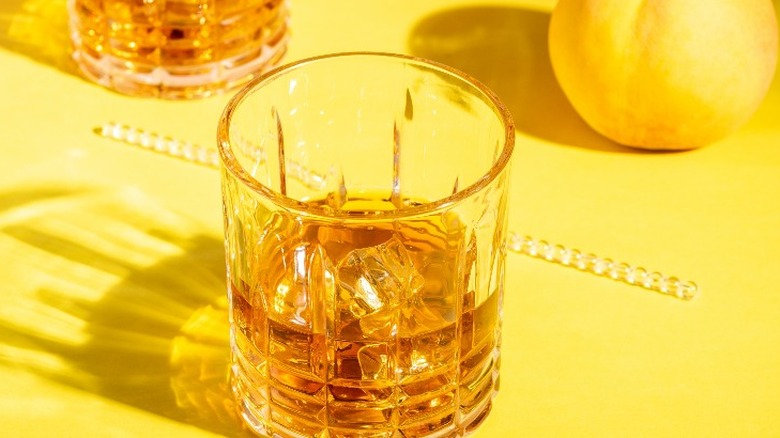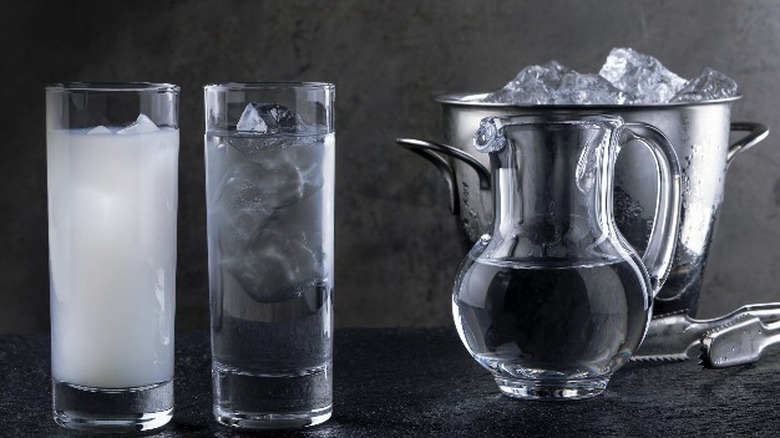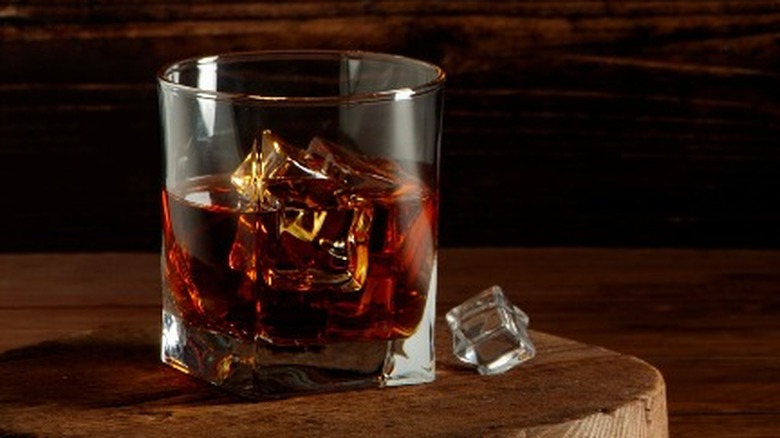12 Types Of Brandy And What Makes Them Unique
The world of brandy is a vast one. But if you've ever wondered what makes a Cognac different from an Armagnac, wonder no more!
Brandy is a category of spirit that is made from distilled wine or fermented fruit juice. Its name derives from the Dutch word "brandewijn," which translates to "burnt wine" (via Ohio Liquor). The French were distilling wine in the early 16th century, but the Dutch would popularize the spirit and make it go global. As the Dutch traveled the world, they wanted a way to transport this delicious French wine they were buying up. They found that it was much easier to fit on the boat if they distilled it down and decreased its volume.
Simply put, distillation is the process by which a liquid is separated or purified, according to Liquor.com. For alcohol, that means an alcoholic beverage is separated into alcohol and water through the processes of evaporation and then condensation, resulting in a more concentrated, pure alcohol that's higher in alcoholic concentration than the original mixture. Despite its storied history, brandy remains as current as ever, as it continues to gather fans around the world. Keep reading to find out more about the different types of brandy and how they're produced across the globe.
Cognac
One of the first things to remember about brandy is this: All Cognac is brandy, but not all brandy is Cognac. That's because for a brandy to be a Cognac, it must be distilled from white wine and follow a stringent set of steps, as well as adhere to certain aging requirements. Much like Champagne, for example, which has to be made in the Champagne region of France, Cognac must also be produced in the Cognac region.
According to Eater, Cognac dates back to the 1600s when French winemakers distilled wine to compete with Dutch distillers. Although it took some time for the specific Cognac process to come about, today all Cognacs must be distilled twice. It's also a requirement that Cognac is distilled in copper pot stills. Cognac shipped 7% more bottles in 2021, reported the official Cognac website, which proves that this ancient drink still has a firm hold on its adoring fans.
Cyprus
In Cyprus, the island in the Mediterranean that's off the southern coast of Turkey, brandy is made from fermented Xynisteri grapes. This grape is indigenous to Cyprus and is found in Cypriot wines and desserts (via Annabelle Hotel). The result is a spirit that is lighter than other brandies.
It is common to drink Cypriot brandy as brandy sour. And because brandy is commonly consumed in cocktails, it's slightly more neutral in flavor, but has distinct caramel notes. The brandy sour cocktail was originally created as a way to pass off alcohol as iced tea for Egyptian King Farouk during his visit to Cyprus in the 1930s, according to Reuters.
If you'd like to try a Cypriot brandy sour as Stelios Sourmelis invented it way back when, Cyprus Travel Secrets suggests that you grab some bitters (preferably Angostura), soda, and some Cypriot lemons, which give the drink its distinct refreshing characteristics.
Armagnac
Armagnac is another brandy that may sound familiar but isn't quite as popular as cognac. This brandy hails from Southwest France in a region called Gascony. Cognac is distilled twice, but Armagnac undergoes single distillation in a device called an alembic armagnaçaise, explains Liquor.com. At that point, it undergoes a period of aging in oak barrels.
This is not a brandy that's made in bulk. It is a regional specialty that's made with a variety of grapes from the area. The unique blend of grapes and Gascony terroir bring a certain style and flavor to Armagnac that can't be replicated anywhere else. LA Times reports that Cognac is produced in volumes 10 times higher than Armagnac.
The taste of Armagnac is harder to pin down than, say, Cognac because its range across vintages can be great. If a distiller decides to age Armagnac for a longer period, you'll pick up some more spice notes from the oak barrels. And if it's aged for a shorter period, it'll be lighter in color, since it hasn't picked up as much color from the oak barrels and will have taste slightly fruitier. Because Armagnac is made in smaller volumes, it's not exported nearly as much as Cognac. So you'll need to pay a visit to the region to try the very best.
Applejack
Apple lovers rejoice! There's a brandy for you, and its name is a dead giveaway that it's slightly different than other brandies.
Apple brandy is a little tricky because regionally, it's called Calvados (which we'll touch on later) or Applejack, depending on where you're drinking it. According to Eight Oaks Distillery, Applejack is the American version of apple brandy. The 'jack' in applejack refers to the process of jacking, which is freeze distillation that separates the alcohol and water content through a freezing process. Applejack is also supplemented with other grain spirits, so it's not quite a brandy, but is close enough and often mentioned under the general category.
Apple brandy originates in France, while Applejack is a distinctly American spirit. Today, freeze distillation is not so common with American applejacks, but the name persists. If you're sipping on Applejack, you may pick up some notes of rich baking spices and caramel, which come from the Bourbon barrels that are used in Applejack aging.
Brandy de Jerez
If you're a fan of the spirit Sherry, you may be familiar with Jerez. This southwestern Spanish city, full name Jerez de la Frontera, is the world capital of Sherry, but they also make a brandy. According to the official Brandy de la Jerez website, Jerez Brandy has its own regional properties that make this drink totally different from other types of brandy. Brandy from Jerez, Spain must be aged in American oak barrels. These barrels must have been previously used to age Sherry, which imparts some of sherry's signature notes into the brandy.
Jerez has an ancient brandy-producing history, which dates back to 711 AD. This brandy is made with grapes that are native to Spain — Airén and Palomino. As with sherry, Jerez Brandy uses a solera system, which is a layered barrel system that allows for precise blending. With such a storied history, Jerez Brandy is perfect in a glass all on its own. But you can also try to drink your Jerez Brandy at cooler temperatures and drink it as a shot.
Pisco
Venture to Peru once, and there's a strong chance you'll encounter Pisco. This drink is the national spirit of Peru, and has actually been adapted into any cocktails that have made their way around the world.
If you're a fan of cocktails, you might know the pisco sour or pisco punch. According to Taste Cocktails, Pisco is a brandy that doesn't undergo aging like most of its peers. Pisco puro uses only one grape, oftentimes the indigenous Quebranta variety. There's also Acholado Pisco, which is made from a blend of grapes, and Mosto Verde Pisco. The latter is a rare form of pisco that is made from grape juice that is only fermented part way.
Pisco is a historic brandy that is reported to date back to the 16th century, when grapevines were brought to Peru by Spanish colonists. As for aging, which you might have noticed by now is a common trait amongst brandies, Pisco is only aged for at least three months in neutral containers. No oak barrels here! Pisco has a pure flavor that has no spice or warm notes like other brandies, and it's bottled pretty soon after the aging process.
Peach brandy
We've covered brandy made from grapes and apples. Is there any way brandy could get even more interesting? If you consider there's a peach brandy, then the answer is yes!
Brandy is an ancient form of fruit juice distillation that can be traced back to Muslims in the 8th century, who used the concoction for medicinal purposes. Peach brandy is a spirit that plays on this tradition, but uses peaches instead of grapes. It is more common, however, to add peach flavoring instead of using actual peaches, explains Delighted Cooking.
It's important to note that peach brandy is sweet. This can be perfect depending on how you want to drink it. It's an ideal digestif for this reason. But don't be fooled! You may also love peach Schnapps and think they're interchangeable, but according to That Cocktail, Schnapps is a more general term for a strong spirit, which has a varied definition depending on which European country is producing it. Peach brandy is great as a shot or a slow-sipping aperitif, but you can leverage its sweetness to make several cocktails.
Stravecchio/Grappa
If you're a fan of the zero waste movement, you'll love Grappa! This Italian brandy is made from grapes, seeds, and stems. According to Eataly, a good Grappa should convey the grape's notes and terroir. It's certainly a strong spirit, though, so don't expect anything less than 37% alcohol. It's certainly not for the faint of heart! But if you are lucky enough to sip on a glass of Grappa, you may have had it neat. It's the perfect digestif after a hearty meal.
Grappa must be made in Italy. Also, it must be made from the pomace, which is another name for all of the parts of a grape, like skins, stems, and everything else. And it also must be steam-distilled with the solid parts of the grape. To enjoy Grappa, simply pour it into a glass and sip. But you can also have it as the Italians do, by mixing it with espresso for a 'corrected coffee' or caffè corretto!
Kanyak/Raki
Raki is a spirit that is renowned across the globe as the national drink of Turkey. It's actually popular in a few other countries, including Greece (specifically on the island of Crete), Kazakhstan, and more. But in Turkey, raki is defined as a brandy that's made from grapes and even raisins. The spirit also takes on some flavor from anise, which is used to add flavor.
Raki is clear on its own, but when mixed with water or served with ice, it takes on its signature milky hue. As Turkey Travel Planner states, Raki was once exclusively produced by a brand, Tekel, which had a monopoly on Turkish spirits and tobacco. Today, the ability to produce Raki has been extended to other companies. This shift in producers has led to new flavors.
In Turkey, Raki is sipped during a meal. The licorice or anise taste is perfect to help digest a heavy meal.
Divin
Divin is a little-known brandy produced in the Eastern European country of Moldova. Divin means "divine, marvelous, wonderful" in Moldovan, explains Deluxe Wine and Spirits. It looks similar to the word divine and was clearly also influenced by it... and Divin certainly is a magical brandy!
It's actually produced using Cognac methods so you may notice that the taste is similar. That's because in1958, Moldova signed the Lisbon Agreement. Once it gained independence, it agreed to stop using the official Cognac title, according to Wine and Spirits MD. That didn't change the quality, though — and today, Divin is known as a nice alternative to Cognac.
The brandy must be aged for three years, and is also made with some sugar and water, which is then aged for another few years. A few grapes are allowed, including Aligote, Ugni Blanc, Riesling, and Colombard. To drive Divin, no special rules are needed. Just enjoy as you would cognac — in snifters at room temperature. It's a delicious way to get a feel for how one might experience life in Moldova.
Calvados
We've already touched on apple brandy, but the apple brandy that derives from Normandy, France is so special that it's referred to by its own name.
Calvados is Normandy's very own contribution to the world of brandy, and this spirit is made with apple cider that may also contain a small amount of pear cider. According to Wine Enthusiast, apple brandy was first mentioned in the 1500s, but Calvados didn't become popular in France until infestations of the pest phylloxera ruined vineyards, affecting both the wine and Cognac supply. French farmers needed to make a living,and turned to their apples to create an income stream.
Today, Calvados is enjoyed between courses as a way to aid in digestion during a long, leisurely meal. You should pick up notes of apples, of course, along with pears. And if it's been aged, then you will also notice some hints of baking spice. It's remarkable that something as good as Calvados came out of such a bad situation!
South African brandy
South Africa and brandy have enjoyed a long history together. As Forbes explains, Brandy production is centered in the Cape region of South Africa, which is also a hub of wine production.
If you think about the history of Cognac as well as of South Africa, it makes sense that the drink has found a home there. The Dutch popularized the spirit and also made their way to South Africa, bringing their drink along with them. It was 1672 when South Africa made its first wine, and it would be only 13 years later when they distilled brandy.
There are a few requirements that South African brandy must meet. For starters, it must be made from local grapes. Colombard and Chenin Blanc are the most commonly used grapes. South African brandy must also be produced and aged locally. Although South African brandy isn't as famous as French brandy, it's worth tasting if you're able to. Expect some fruity notes, particularly apricot and peach.





